APPLICATION OF HYBRID GENETIC ALGORITHM IN AEROELASTIC MULTIDISCIPLINARY DESIGN OPTIMIZATION OF LARGE AIRCRAFT
2013-12-02TangChanghong唐长红WanZhiqiang万志强
Tang Changhong(唐长红),Wan Zhiqiang(万志强)
(1.School of Mechanical and Engineering,Northwestern Polytechnical University,Xi′an,710072,P.R.China;2.School of Aeronautic Science and Engineering,Beijing University of Aeronautics and Astronautics,Beijing,100191,P.R.China)
Nomenclature
B Dampling matrix
b Reference half chord length
GFACT Scalar normalization factor
g Inequality constraint
K Stiffness matrix
k Reduced frequency
M Mass matrix
ndvNumber of design variables
nconNumber of constraints
ndispNumber of nodes
nrootNumber of flutter roots
nvNumber of user-specified velocities P Applied load vector
p Eigenvalue in p-k method
Q Aerodynamic influence coefficient matrix
q Dynamic pressure
u Displacement vector
V Flow speed
v Design variable vector
ρ Local atmosphere density,or material density
γ gvalue of flutter mode
ζ Displacement limit superscripts and subscripts
a Displacement vector set of a-set,i.e.analysis set,in which single point constrain and multipoint constrain have been omitted,and Guyan reduction has been performed
h Modal analysis set,h-set
I Imaginary part
i Design variable identification
j Constraint identification
R Real part
x Displacement vector set of x-set,i.e.″aerodynamic extra point″set
other symbols
()lowerLower bound
()upperUpper bound
()fFlexible case
()rRigid case
INTRODUCTION
It has been well-known that the high-aspectratio swept wing is an important aerodynamic configuration because it has better aerodynamic performance available for civil airplane and military transport.Meanwhile,this aerodynamic configuration has been widely used by several airplanes such as Boeing 737,Airbus 320,C-17,C-5,IL-76and so on.The advanced aeroelastic optimization technology,as well as structure and aerodynamic optimization technology,has been developed sufficiently for the development of these aircraft[1-2].
As a technology to improve the aeroelastic characteristics of aircraft,aeroelastic optimization technology takes advantage of the reasonable distribution of structural strength and stiffness to attain beneficial deformation increasing overall performance.In the past decades,a large amount of theoretical and experimental work was carried out in this field to meet the modern requirements for high performance together with a lightweight structure.
Since the 1980s,a lot of large programs have been developed to tackle the optimization problem of weight minimization with aeroelastic constraints.Amongst them,TSO[3],FASTOP[4],ADOP[5],MSC/NASTRAN[6],and ASTROS[7]have found wide recognition and application.Most recently,MSC/NASTRAN and ASTROS have become the international criteria of advanced design optimization with aeroelastic constraints[8].
The optimization algorithms used in all the above mentioned programs are gradient-based.Though strong in local search and quick to converge,the gradient-based algorithm often falls into local optima,and,moreover,the initial values of design variables have great effects on the optimization results,e.g.different initial values of design variables can lead to different optimization results,which proves,therefore,to be the inherent demerit of the gradient-based optimization algorithm.To solve these problems,more sophisticated approaches are required,such as genetic algorithm and simulated annealing algorithm,of which the former is wider used.
Genetic algorithm is an efficient global search that mimics the process of natural selection[9].As a well-known evolutionary computation technique,the genetic algorithm,unlike conventional algorithms,begins with a pool of points,usually known as individuals,followed by making iterative adaptations from the previous generation to the next on the base of the genetic operators and the fitness function.Since introduced by Hollandin[10],genetic algorithm has been used by many researchers as a tool for search and optimization,and it has been receiving serious consideration in aircraft multidisciplinary optimization[11-13].However,it is time-consuming and not well suited for localized optimization.
In the past,the genetic algorithm was not adequately developed and widely applied to aircraft structure optimization because of the limited speed of computers,and the research work was mainly focused on the simple structures with a small amount of design variables and constraints.Recently,as a result of the rapid growth in speed,data transfer and storage capabilities in modern computers,it has become possible to use them in dealing with the optimization of complicated models with a large amount of design variables and constraints.
In order to increase search speed of the ge-netic algorithm,in the past years,various methods of hybridization were suggested to overcome the above shortcomings[14].The role of the local search in the context of the genetic algorithm has been highly valued and many successful applications have shown strongly in favor of such a hybrid approach[15].Because it incorporates the merits of the genetic algorithms and the local algorithms,the hybrid algorithm often outperforms either of them operated alone.
Being a common form of the hybrid genetic algorithms,the combination of the genetic algorithm and the gradient-based one[15],known as genetic/gradient-based hybrid algorithm,is an effective measure to achieve the global optimum thanks to combining the merits of the two elements.It can remarkably increase the convergence speed of search[16]and overcome the demerits of either.In the hybrid algorithm,the genetic algorithm is used to perform a global search to avoid local optima and to make the search direction point to an excellent zone at the initial stage or after some generations.The gradient-based algorithm is further used to fine-tune the excellent individuals of every generation optimized by the genetic algorithm to achieve the local optima and to further the global optima.
In comparison with general structural optimization,aeroelastic optimization has the characteristics of complicated research object,high calculation cost,multiple disciplines,a lot of design variables and complex constraints,etc.especially in the process of aeroelastic optimization for the composite structure.At present,genetic/gradient-based hybrid algorithms have been used in aeroelastic optimization of some aircraft structure with large amount of design variables and constraints.However,the comprehensive application examples of genetic/gradient-based hybrid algorithms have hardly been seen in the field of aeroelastic optimization for large aircraft.
In this paper,agenetic/gradient-based hybrid algorithm is introduced for aeroelastic optimization of large airplane wings in initial design stage as well as in detailed design stage.In the al-gorithm,the program of the genetic element is developed by the authors while that of the gradient-based one borrows from the modified method for feasible direction in MSC/NASTRAN software.The consistence of optimization results of different models is also discussed,while sensitivities of constrains with respect to all kinds of design variables are analyzed.
1 FORMULATIONS OF DESIGN STUDIES
1.1 Multidisciplinary optimizaton
In the paper,the design studies prove to be a standard problem in finding values of design variables v which
Minimize

Subject to

where F(v)is an objective function meaning the weight of the structure here.Eq.(2)is used to define the inequality constraints.Eq.(3)is used to specify upper and lower bounds (side constraints)on each of the design variables.
1.2 Equation for static aeroelastic response
The basic equation of static aeroelastic response analysis[6,17]is generally stated as follows

When correlative derivation and calculation are performed by Eq.(4),elastic stability derivatives,elastic control derivatives and corresponding trim can be obtained directly.The same goes for deformation,stress and strain of structure.The detailed solution procedure can be seen in Refs.[7,17].
1.3 Equations for flutter and divergence
The p-k method is more suitable for optimization analysis,for the results acquired are closer to the experiments.The flutter stability analysis is based on the p-k method[6]with an equation of the following form


Eq.(5)can also be used to calculate divergence speed when the frequency decreases to zero[7].
1.4 Constraints
In the paper,flutter constraints and three static aeroelastic response constraints have been considered.The static aeroelastic response constraints include those of aileron effectiveness,deformation and strength[17].
(1)Aileron effectiveness constraints
The aileron effectiveness is represented as[17]

where∂Cmx/∂δais the rolling moment due to aileron deflection,andεailethe aileron effectiveness,respectively.
(2)Deformation and strength constraints
The upper and lower limit of the deformation constraints are represented by

where Ajlare user-specified weight factors on structural deformation.With appropriate weightused to define torsional deformation of structure,e.g.twist of wing tip,and stress or strain of elements.
(3)Flutter constraints
While optimizing with flutter constraints,flutter speed cannot be calculated directly;rather,it must be obtained from the V-g figure.Therefore,flutter constraint is generally formulated to satisfy the requirtements for the gvalues of flutter mode at a series of user-specified velocities

where GFACT is a ratio factor which converts the damping values into a range,preferably from 0.1 to 0.5,consistent with other constraints in the design task.
2 OPTIMIZATION ALGORITHM
2.1 Modified method for feasible direction algorithm
The basic modified feasible direction optimization algorithm[18],with some variation,assumes the following form

where vt+1and vtare the design variable vectors in two consecutive cycles of iteration,t is the cycle identification,τthe scalar parameter,and Dthe feasible search direction.
The procedure begins with an initial design vector v0,i.e.t=0.At the same time as t is increased in a manner of t=t+1,the objective functions F(vt-1)and the constraints gj(vt-1)(j=1,…,k+p)are evaluated.A set of critical or active constraints Jis identified,and the gradients of the objective function▽F(vt-1)and those of the constraints▽gj(vt-1)for all jin Jare calculated.The active constraints are the most violated ones and those within a prescribed tolerance of them.A search direction Dtis to be determined through analyzing,andτtis to be found through a one-dimensional search.Eq.(10)is then used to determine vt+1.The preceding procedure is unceasingly repeated with the ever-renewing design variables until the design satisfies the optimal conditions or some other termination criteria.The essential parts of the optimization algorithm consist of:
(1)Finding a feasible search direction Dt;
(2)Finding the scalar parameterτtthat will minimize F(vt-1+τtDt)so as to meet the constraints;
(3)Testing for convergence to the optimum and terminating the procedure when convergence is achieved.
2.2 Genetic algorithm and genetic/sensitivitybased hybrid algorithm
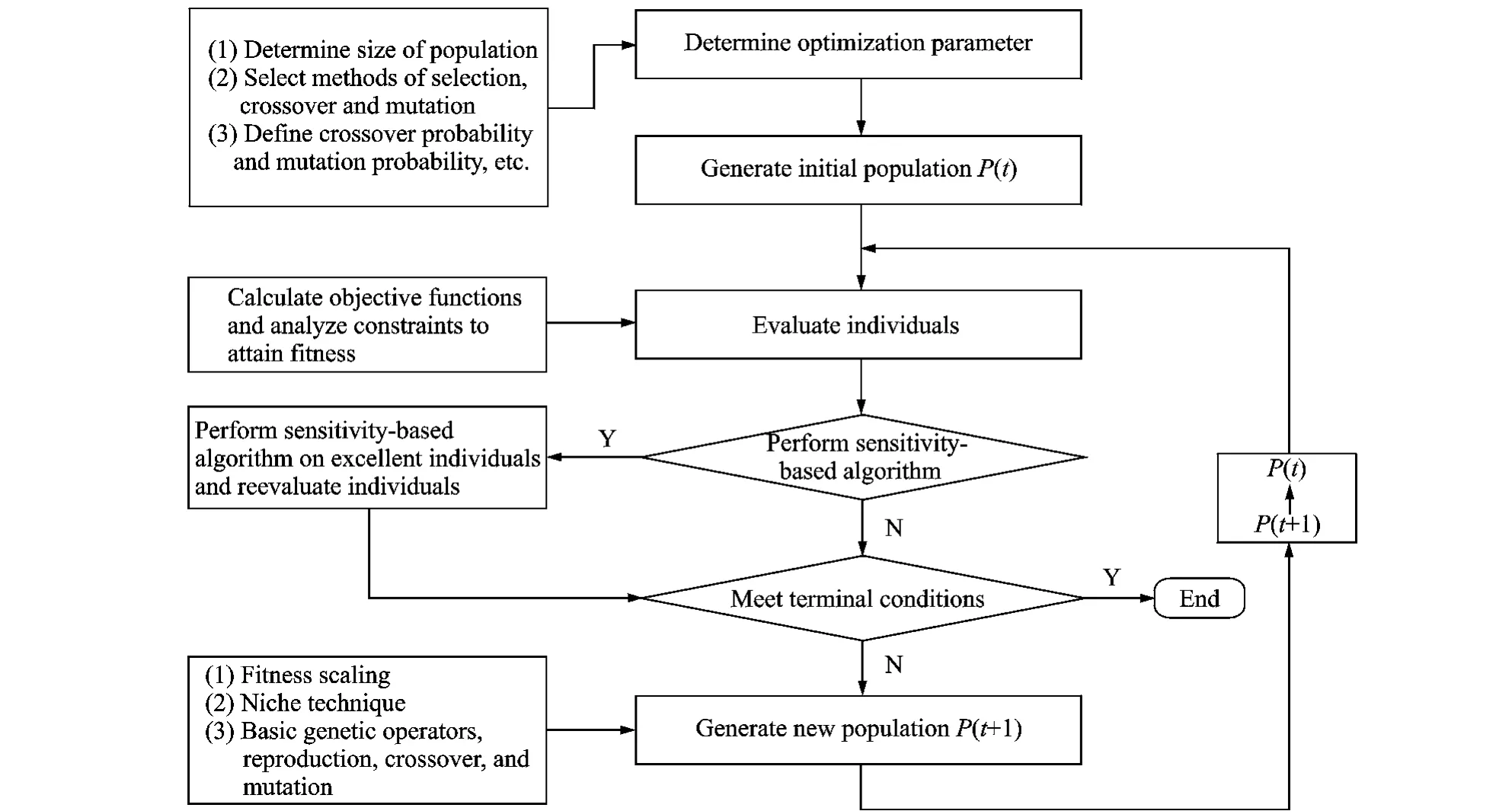
Fig.1 Genetic/gradient-based hybrid algorithm
Fig.1illustrates the flow chart of the genetic/gradient-based hybrid algorithm used in the pa-per.It is one of the genetic algorithms if the gradient-based algorithm is not used.But in the hybrid algorithm,the genetic algorithm is used to perform global search to avoid local optima,while the modified method for feasible directions algorithm is further used to fine-tune the excellent individuals of every generation optimized by genetic algorithm to achieve the local optima.
Software named GA-NASTRAN is developed based on the commercial software MSC/NASTAN.GA-NASTRAN is programmed in FORTRAN90language.The hybrid algorithm mentioned above is carried out by one main program and seven main modules,which have the functions of data input/output,reading information of external individuals,developing the population of the initial generation and the individuals of a new generation,solving the aeroelastic analysis and satisfaction analysis by calling for NASTRAN,and judging the computation convergence.
When an aeroelastic optimization is promoted,firstly,all the data including the model files for NASTRAN analysis and parameters for genetic algorithm,design variables and constrains which determine the genetic strategy should be prepared.The genetic algorithm begins with a population of individuals created at random.Aeroelastic characteristics of each individual in the population thereof are analyzed by NASTRAN,and fitness of each individual is also evaluated.Several individuals which have better quality have been selected and further optimized by the gradient algorithm involved in MSC/NASTRAN.The population is then operated by fitness scaling,niche technique and three main operators(reproduction,crossover,and mutation)to create a better population, which is further evaluated and tested for termination.If the termination criteria are not met,the population is once again operated and evaluated in the way described above.The procedure will not be ended until the termination criteria are met[19].
3 DESCRIPTION OF STUDY CASE
3.1 Calculation models
A subsonic large airplane wing with normal aerodynamic configuration,which has a high-aspect-ratio metal wing,is analyzed.
In initial design stage,the wing can be modeled as a beam-frame finite elementmodel(FEM),and the optimization design procedure can be used to get the appropriate stiffness distribution.The structural FEM is established as Fig.2.The stiffness characteristic of the wing is represented by an elastic beam with different stiffness distribution from root to tip,while the mass characteristic with a set of lumped mass elements.
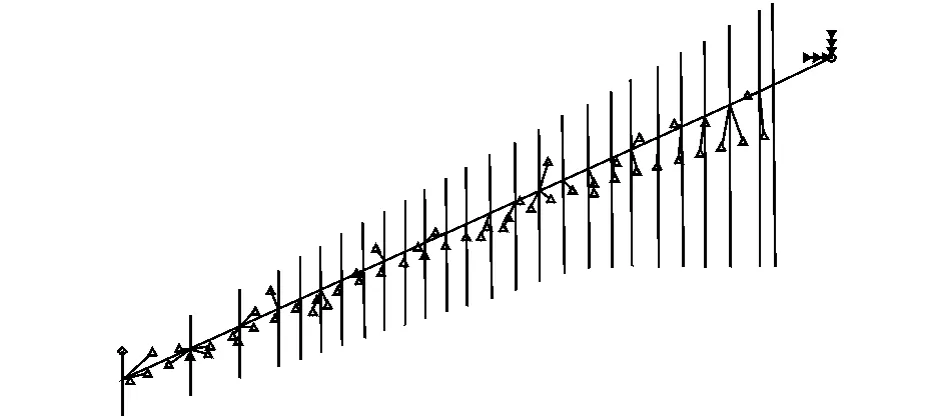
Fig.2 Beam-frame FEM
In detailed design stage,the wing structure can be modeled as three-dimensional FEM,and it is much similar to the reality.Then the optimization design procedure can be used to attain the appropriate thickness distribution all over the wing skin.As shown in Fig.3,the wing FEM is established with shell-rod elements to meet mechanics characteristics of each component.
The aerodynamics is calculated with the subsonic doublet lattice method,as shown in Fig.4.
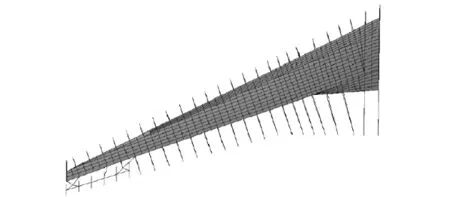
Fig.3 Three-dimensional FEM

Fig.4 Aerodynamic model
3.2 Design optimization
The beam-frame FEM in initial design stage and the three-dimensional FEM in detailed stage are both studied using the aeroelastic optimiza-tion,and was attained the optimized wing stiffness distribution.The effects of design parameters on the constraints are also studied by the sensitivity analysis.
(1)Object function
The optimization in the paper is a weight minimization design.For the beam-frame wing model,the minimized summation of vertical bending stiffness and torsion stiffness at the wing root will be used instead of structure weight.
(2)Constrains
For the beam-frame wing model,vertical displacement at the wing tip should be less than the specified ratio of half span when the airplane goes through pull-up maneuver of the longitudinal maximum overload,and the torsion angle at wing tip should also be less than specified value during the cruise case,as well as the other performance meeting requirements.For the three-dimensional wing model,the aileron effectiveness should remain high enough under the serious pull-up maneuver mentioned above,and the flutter velocity under sea level condition and overall structural strength should be fit for the design requirement at the same time.
(3)Design variables
For beam-frame wing model,the scale coefficient of the initial stiffness of each wing segment is selected.For the three-dimensional wing model,the upper skin thickness,lower skin thickness and spar cap area are selected as the design variables.
4 RESULTS OF STUDY CASE
The spanwise vertical bending and torsional stiffness distribution of beam-frame wing model,and the size of three-dimensional wing structure are all decided using the aeroelastic optimization.Meanwhile,the three-dimensional wing structure is converted to get the equivalent spanwise bending and torsional stiffness distribution.The effects of design parameters on the performance are also studied by sensitivity analysis.
4.1 Comparison of object functions
The unitized object functions of the beamframe and three-dimensional wing model attained by the hybrid algorithm and two conventional methods,one is the gradient algorithm and the other is the genetic algorithm,are compared in Table 1.The data shows that compared with the conventional methods,genetic/gradient-based hybrid algorithm can have better optimize result for both ty pes of analysis model.

Table 1 Object functions obtained by different optimization algorithms
4.2 Comparison of stiffness distribution
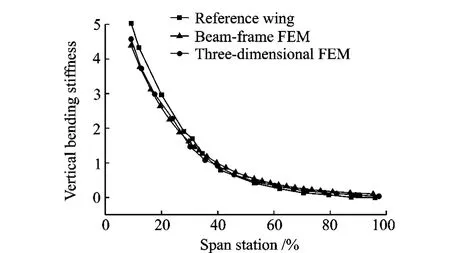
Fig.5 Comparison of vertical bending stiffness
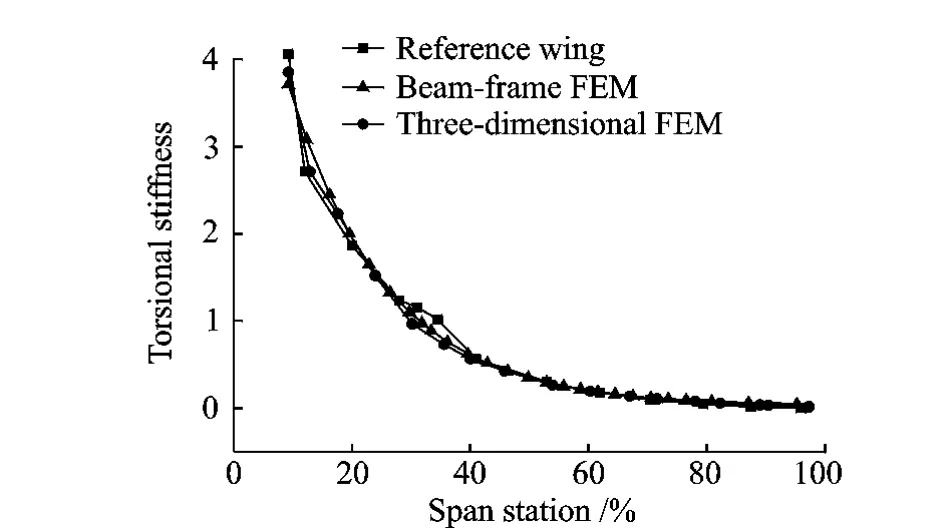
Fig.6 Comparison of torsional stiffness
The nondimensional vertical bending and torsional stiffness for the beam-frame and three-dimensional wing models are compared in Figs.5-6,and the stiffness of a reference wing with the similar structure is also illustrated.The result indicates that the stiffness distribution obtained by these two methods is close to each other,and both of them are similar with the reference wing,which means that genetic/gradient-based hybrid algorithm is applicable in stiffness design of large airplane wing.
4.3 Design sensitivity
In the genetic/gradient-based hybrid algorithm,the sensitivity algorithm can improve the local search efficiency,and the sensitivity information can also be the guide of design optimization.As limited to the length,this paper here only lists the nondimensional sensitivity of bending deformation at wing tip and gvalue in flutter analysis with respect to the bending and torsional stiffness of each wing segment,which is represented as importance index in Fig.7.
Fig.7shows the effect of the stiffness at each wing segment on the wing tip deformation.The larger importance index is,the more significant effect appears.The result shows that the wing-tip deformation is mostly effected by the vertical bending stiffness of inner and middle wing parts,while the effect of torsional stiffness is much smaller.
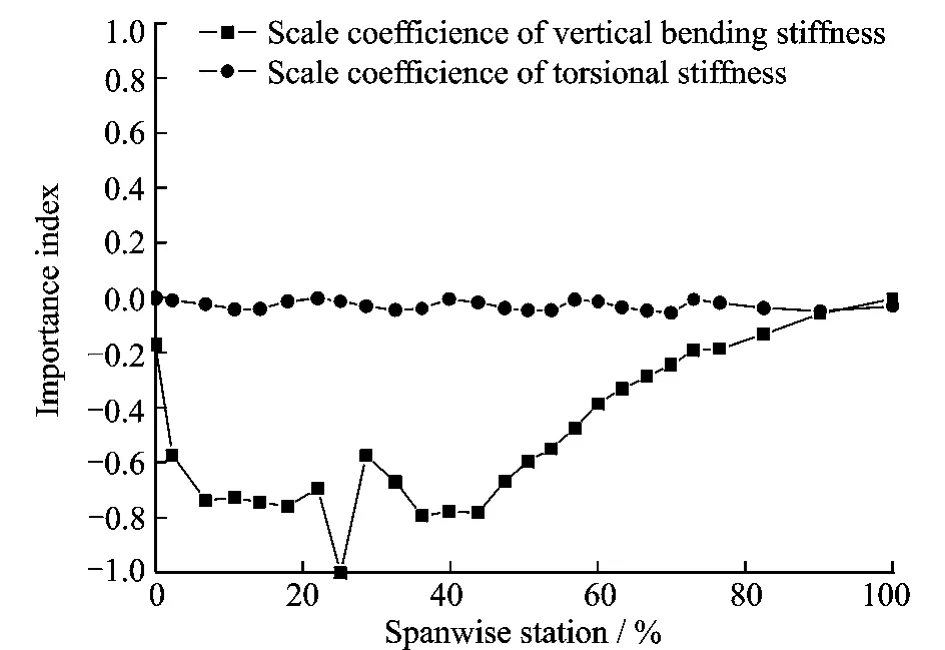
Fig.7 Effect of wing stiffness at different segments on wing-tip deformation
Fig.8shows the effect of the stiffness of each wing segment on gvalue of flutter mode near critical flutter speed in the v-gchart of the flutter analysis,where the g value goes through the 0 damping level from minus to positive.It can make sure that the design is fit for the flutter constraint to reduce the gvalue until it is below 0.The result shows that the gvalue of flutter mode is positive relevant with the vertical bending stiffness,while negative relevant to the torsional stiffness.The torsional stiffness at middle and outer wing parts has great effect on the gvalue level.Therefore,torsional stiffness there should be increased in order to restrain the gvalue level.

Fig.8 Effect of stiffness of beam-frame wing on gvalue of flutter mode
4.4 Comparison of skin thickness
The genetic/sensitivity-based hybrid algorithm is applied to the wing structure optimization meeting the aeroelastic and the strength constraints.The optimized results of upper skin are shown in Fig.9in comparison with the one of initial wing subject to strength constrains.
The results show that the main difference of skin thickness is located at middle segment due to aeroelastic constraint,and the wing skin at the middle segment subject to aeroelastic constraint and strength constraint are thicker than the one only meeting strength constraints.The trend is consistent with the abovementioned sensitivities analysis results.In addition,the thickness distribution of the lower skin is similar to the one illustrated in Fig.9.
5 CONCLUSIONS
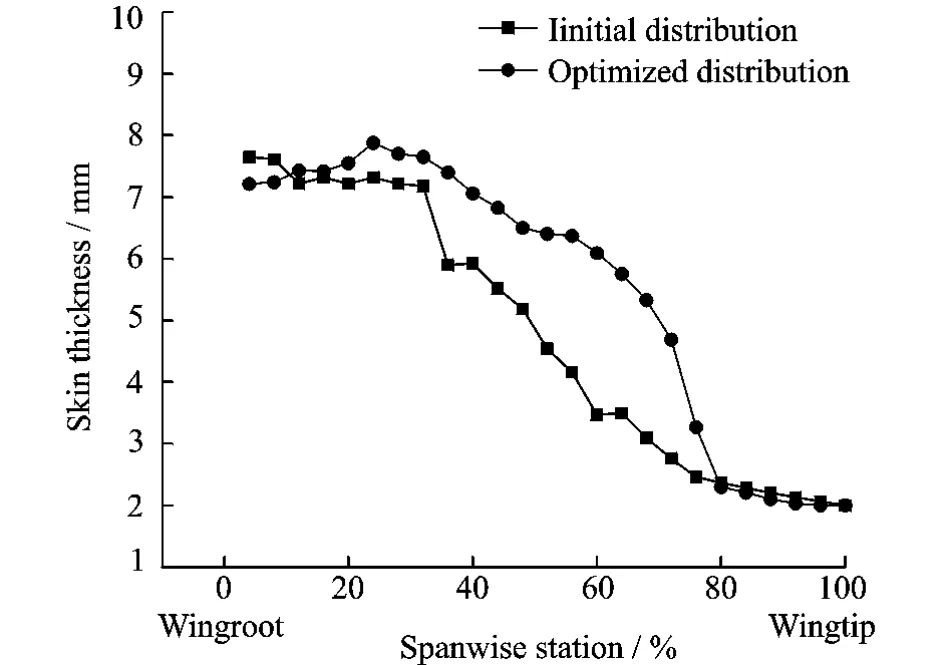
Fig.9 Comparison of torsional stiffness
The application of the genetic/gradient-based hybrid algorithm in the aeroelastic optimization of large airplane wing is introduced.With the comparison of stiffness distribution of both beam-frame wing model and three-dimensional wing model,the sensitivity analysis of structural variables,and the comparison of thickness distribution of initial and optimized three-dimensional wing models,the following conclusions are attained.
(1)The genetic/gradient-based hybrid algorithm is available in aeroelastic optimization of large airplane.It can be used in design optimization of wing stiffness at the stage of initial design,as well as in size design optimization at the stage of detailed design.The stiffness distribution obtained in both cases is consistent.
(2)In the genetic/gradient-based hybrid algorithm,the sensitivity information can be the guide of design optimization,as well as improve the local search efficiency.
As limited to the length,the paper here only lists some macroscopic and initial analysis results.More optimization results and interaction roles can be obtained using the genetic/gradient-based hybrid algorithm,which can provide valuable advices for engineering.
[1] Bindolino G,Ghiringhelli G,Ricci S,et al.Multilevel structural optimization for preliminary wing-box weight estimation[J].Journal of Aircraft,2010,47(2):475-489.
[2] Battoo R S,Visser J A.Aeroelastic and strength optimization of a large aircraft wing with wing parameter variations[R].AIAA Paper 1998-1821,1998.
[3] Lynch R W,Rogers W A,Braymen G W,et al.Aeroelastic tailoring of advanced composite structures for military aircraft,Volume III—Modification and user′s guide for procedure TSO[R].AFFDL-TR-76-100,1978.
[4] Markowitz J,Isakson G.FASTOP-3:A strength,deflection and flutter optimization program for metallic composite structures[R]. AFFDL-TR-78-50,1978.
[5] Dodd A J,Kadrinka K E,Loikkanen M J,et al.Aeroelastic design optimization program[J].Journal of Aircraft,1990,27(12):1028-1036.
[6] Rodden W P,Johnson E H.MSC/Nastran aeroelastic analysis user′s guide V68[M].Log Angeles:MSC Software Corporation,1994:657-698.
[7] Neill D J,Johnson E H,Canfield R.ASTROS—A multidisciplinary automated structural design tool[J].Journal of Aircraft,1990,27(12):1021-1027.
[8] Danilin A I,Weisshaar T A.The use of structural optimization criteria for aircraft conceptual design[R].AIAA Paper 2000-1328,2000.
[9] Guan J,Aral M M.Progressive genetic algorithm for solution of optimization problems with nonlinear equality and inequality constraints[J].Journal of Applied Mathematical Modelling,1998,23(4):329-343.
[10]Holland J H.Adaptation in natural and artificial systems[M].Ann Arbor:University of Michigan Press,1975:183.
[11]Raymer D P,Crossley W A.A comparative study of genetic algorithm and orthogonal steepest descent for aircraft multidisciplinary optimization[R].AIAA Paper 2002-0514,2002.
[12]Perez R E,Chung J,Behdinan K.Aircraft conceptual design using genetic algorithms[R].AIAA Paper 2000-4938,2000.
[13]Daly P,Ngo D.Multidisciplinary structural optimization utilizing genetic algorithm capabilities(for C-17 Horizontal Stabilizer Rib Design)[R].AIAA Paper 98-4776,1998.
[14]Orvpsh D,Davis L.Using agenetic algorithm to optimize problems with feasibility constrains[C]∥Proc of 1st IEEE Conf on Evolutionary Computation.Orlando,FL,USA:IEEE,1994:548-553.
[15]Cheng R,Mitsuo G,Tsujimura Y.A tutorial survey of job-shop scheduling problems using genetic algorithms,Part II:Hybrid genetic search strategies[J].Computers & Industrial Engineering,1999,36(2):343-364.
[16]Davis L.Bit-climbling,representational bias,and test suite design[C]∥Proceedings of Fourth International Conference on Genetic Algorithm (ICGA 4).San Diego,CA,USA:[s.n.],1991:18-23.
[17]Neill D J,Herendeen D L,Venkayya V B.ASTROS enhancements.Vol.3:ASTROS theoretical manual[R].AD Paper A308134,1995.
[18]Eastep F E.Aeroelastic tailoring of composite structures[J].Journal of Aircraft,1999,36(6):1041-1047.
[19]Herrera F,Verdegay J.Genetic algorithms and soft computing[M].Heidelberg,Germany:Springer-Verlag,1996:3-29.
猜你喜欢
杂志排行
Transactions of Nanjing University of Aeronautics and Astronautics的其它文章
- FLEXURAL CAPACITY OF RC BEAM STRENGTHENED WITH PRESTRESSED C/AFRP SHEETS
- MINIMUM ATTRIBUTE CO-REDUCTION ALGORITHM BASED ON MULTILEVEL EVOLUTIONARY TREE WITH SELF-ADAPTIVE SUBPOPULATIONS
- OUTPUT MAXIMIZATION CONTROL FOR VSCF WIND ENERGY CONVERSION SYSTEM USING EXTREMUM CONTROL STRATEGY
- ACTIVE VIBRATION CONTROL OF TWO-BEAM STRUCTURES
- IMPROVED DOPPLER WARPING METHOD FOR AIRBORNE RADAR WITH NON-SIDELOOKING ARRAY
- MULTI-OBJECTIVE PROGRAMMING FOR AIRPORT GATE REASSIGNMENT
